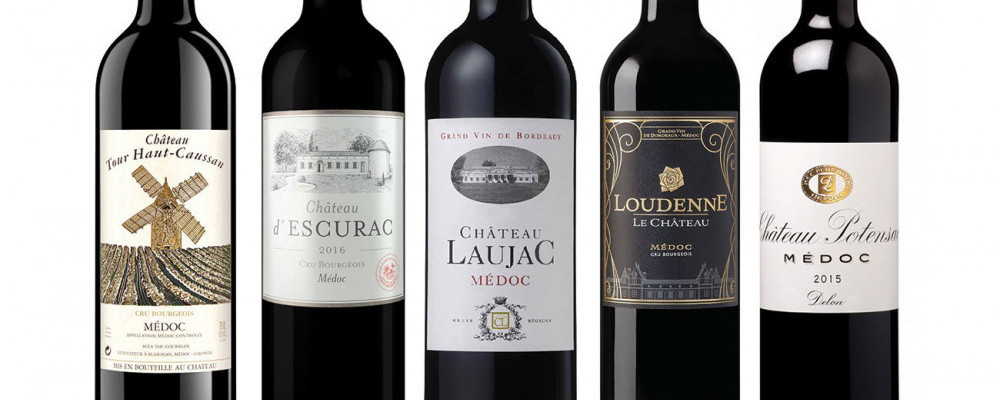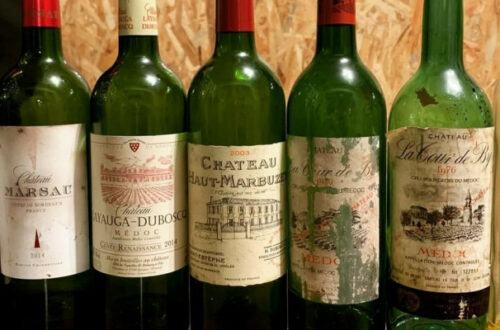
What does Médoc taste like?
For those who’ve been following me for a while, you would know what kind of wine is a Médoc wine. If you’re new don’t worry, I’ll start by reminding you of the key points.
First, let’s a clear up one thing : do not mix up the AOC Médoc and the geographical area.
Indeed, the French have made it confusing (are you really surprised) but Médoc has two definitions.
Médoc is a large geographical area, which contains Les Landes, Bas Médoc and Haut-Médoc AND an AOC, much smaller geographical area but is still one of the largest AOC.
What kind of wine is a Médoc? – a summary
Let’s start by stating the obvious : Médoc wines are usually Cabernet Sauvignon-dominated blends. The other grape varieties that constitute such a blend are Merlot mostly, and splashes of Petit Verdot, Malbec and Carmenère (though not always).
Why are Médoc wines blends? Because Bordeaux is subject to the vintage effect. This means the weather changes a lot from one year to another. So relying on one grape variety alone would be too risky.
Why a blend of Cabernet Sauvignon and Merlot? The Médoc didn’t exist in the Middle Ages during the rise of Bordeaux. We had to wait until the 17th century for the Dutch to come and drain the whole area.
After they drained the whole place, they put a lot of gravel, which is a mixture of pebbles, sands and clays.
The pebbles are brought by the Garonne and the Dordogne rivers. These soil absorb and transmit heat, which is ideal for late-ripening grape varieties. And especially these soils are ideal for Cabernet Sauvignon! Thus, wines from the Médoc will be Cabernet Sauvignon-dominated blends.
However, the Dutch didn’t put only gravel but also a lot of limestone clay, which, with its draining properties, is ideal for Merlot. This explains why there are nearly half of the vines that are Merlot plantings.
If you want to know more, feel free to read the whole post on this subject.
What does a wine from the Médoc region taste like?
As we said, Médoc wines are a blend of Cabernet Sauvignon and Merlot.
Cabernet Sauvignon is a grape with thick skin which bring color and tannins to the wines. It has high acidity and herbaceous and black fruit aromas.
Merlot has a medium acidity with medium tannins and offers different fruit characteristics according to its level of ripeness. It can deliver red fruit and herbaceous aromas and flavors to cooked black fruit.
These two grapes are often blended because Merlot will help lower the tannins and acidity levels and make the wines more ready to drink at an early age. It will also add red fruit flavors to the blends.
Cabernet Sauvignon will balance a wine’s acidity and add tannins.
Thus, young wines from Médoc will present aromas of cassis, blackberry, black cherry, liquorice, vanilla, coffee bean, spices… When aging, these aromas will become tobacco leaf, truffle, cigar, leather, spices, wet soil…
An overview of the taste of all the AOC in the Médoc
Let’s take a look at the AOCs now that we’ve got a general idea. Indeed, the diversity of terroir in the sub appellations of Haut-Médoc is quite impressive.
- The Médoc AOC has mixed clay-limestone and gravel soil. It tastes better in the warmer vintages because it gives the opportunity to the grapes to fully ripened and wines are then more concentrated. The main aromas are liquorice, red and black fruit, cherries, vanilla from the oak and can taste as toasted coffee with bottle aging.
- Saint-Estèphe, being the northernmost appellation with clay-dominant and gravelly soils, most wineries will tend to put more Merlot in the blend. The wine will taste fruitier with red blackcurrant flavours with notes of violet, vanilla and spices. The Cabernet Sauvignon will bring structure to the wine, making it elegant.
- Pauillac is rich in gravel soils. Cabernet Sauvignon will highly dominate and thus bring its flavours of black fruit, such as dark cherry or blackcurrant, cedar and smoke from the oak. It will have high tannins making the wine dense and powerful. However, the quality is not the same on all the appellation, depending if it’s on the lower or the higher part of the appellation.
- St Julien is also rich in gravel soils. Wines will be complex and powerful with velvety tannins (St – Julien is south to Pauillac so with a warmer climate and the Cabernet Sauvignon will be riper, hence the softened tannins). The wine will have notes of black fruit such as blueberry, blackcurrant, blackberry and spices like liquorice. It will develop tobacco notes with age.
- Haut-Médoc has terraces of alluvial gravel deposits, slight favorable to Cabernet Sauvignon and deep and clay soils, favorable to Merlot. This is actually the AOC where Merlot has the highest percentage in the Cabernet Sauvignon-dominated blends. This is a complex and powerful wine with red and black fruit flavours. I often get eucalyptus notes and leather, with age.
- Listrac Médoc has three Pyrenean gravel terraces. So it’s back to full Cabernet Sauvignon’s flavours with its black fruits and spices. These are well-balanced and structured wines.
- Moulis en Médoc has gravelly soils with clay limestone layers. This makes a more complex wine with a larger aromatic palette. Being more in the south, the tannins are softer and velvety in the mouth.
- Margaux is the southernmost AOC, covered by the Garonne river gravel. With its warmer climate, the Cabernet Sauvignon ripens fully so the wines will feel silky, velvety in the mouth. Merlot is usually very present in the blends too so you’ll often find fresh red fruit aromas along with the usual Cabernet Sauvignon aromas. These are very powerful wines. (For a 80€ tour of wineries in the Médoc with transport included, you can actually taste a Margaux wine! If you’re interested -and you should because it is of great value, you can find the information in my post where I’ve selected the best tours for you)
Conclusion
By now, you should have a rough idea of how a Médoc wine tastes like. Although it’s mostly Cabernet Sauvignon-dominated blends, the part of Merlot changes according to the kind of soil constitutes the vineyard. Add the impact of the winemaker afterwards and you’re in for a large palette of styles!
Seeing as the best way to know what a Médoc wine tastes like is to actually taste it, you can either :
- sign up to a wine club, such as SomMailier, who delivers French wine directly from the winemaker to your doorstep.
>> Get the full review here <<
- or come to France and visit the Médoc! I’ve drafted for you a whole schedule on your stay in Bordeaux where I recommend some of my favorite tours. Read the post here.







